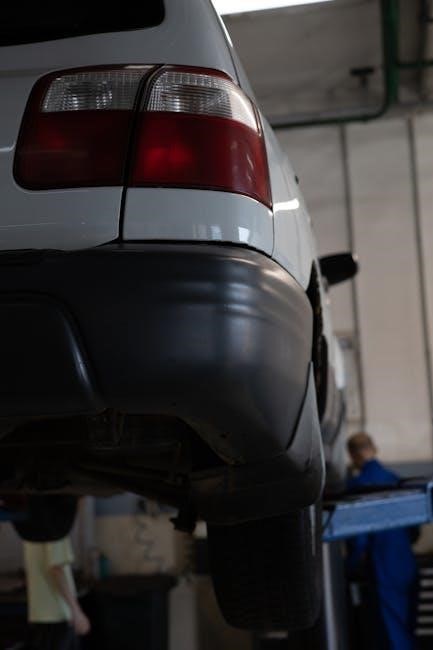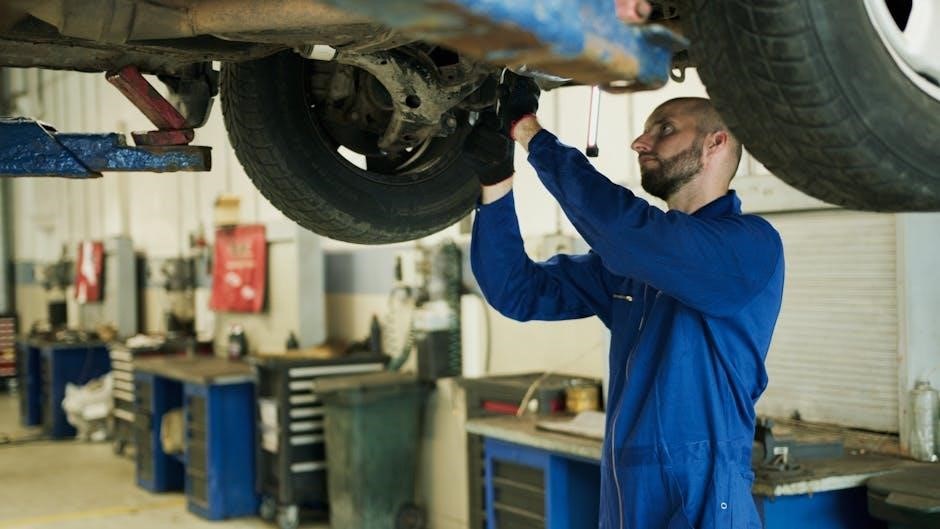Understanding Pontoon Lifts
A pontoon lift is a structure designed to support and protect boats, lifting them out of the water to prevent damage and reduce maintenance needs. Available in stationary or floating designs, these lifts are tailored for various boat sizes and water conditions, ensuring durability and convenience for boat owners.
1.1 What is a Pontoon Lift?
A pontoon lift is a specialized structure designed to support and elevate boats out of the water, protecting them from damage and reducing maintenance needs. These lifts are typically used in marinas or private docks and come in stationary or floating designs. They are ideal for boat owners seeking to preserve their vessels from environmental wear and tear. Pontoon lifts are customizable to fit various boat sizes and water conditions, making them a practical solution for long-term boat care.
1.2 Types of Pontoon Lifts
Pontoon lifts are available in two primary types: stationary and floating. Stationary lifts are fixed to the dock and suitable for calm waters, while floating lifts adjust to water levels, ideal for areas with fluctuating tides. Some lifts feature sliding boards between pontoons for guidance, enhancing stability. Each type offers unique benefits, catering to different boat sizes, dock setups, and environmental conditions, ensuring a tailored solution for boat owners seeking efficient and reliable lifting systems.
1.3 Benefits of Using a Pontoon Lift
Using a pontoon lift offers numerous advantages, including protection from water damage, reduced maintenance, and prevention of algae growth. It also minimizes hull abrasion and makes cleaning easier. By lifting the boat above water, it extends its lifespan and reduces the need for frequent repairs. Additionally, a pontoon lift can enhance the appearance of your dock and provide a stable platform for maintenance or repairs, ensuring your boat remains in optimal condition year-round.

Key Components of a Pontoon Lift
A pontoon lift consists of frames, lifting mechanisms, guide systems, and decking. These components work together to securely elevate and support the boat, ensuring stability and protection.
2.1 Frames and Support Structures
The frame and support structures are the foundation of a pontoon lift, providing stability and durability. Typically made from durable materials like steel or aluminum, these frames are designed to withstand various water conditions and support the weight of the boat. They are often customizable to fit specific dock setups, ensuring a secure and level base for the lift. Proper installation of these components is crucial for the lift’s functionality and longevity.
2.2 Lifting Mechanisms
Pontoon lift mechanisms, such as hydraulic or cable systems, are designed to raise and lower the boat efficiently. Hydraulic systems offer smooth operation and high weight capacity, while cable systems are simpler and cost-effective. Both mechanisms are engineered for durability and reliability, ensuring safe and controlled movements. Regular maintenance, such as lubrication and inspection, is essential to extend their lifespan and performance. Proper alignment and balance are also critical for optimal functionality and to prevent structural strain.
2.3 Guide Systems
Guide systems are essential for aligning and stabilizing the boat as it is lifted. These systems often feature sliding boards or frames that run alongside the pontoons, ensuring proper positioning. Made from durable materials like aluminum or steel, they provide smooth operation and protect the boat from shifting during lifting. Regular lubrication and inspection of the guides are crucial for maintaining their functionality and ensuring safe, precise alignment every time the boat is raised or lowered.
2;4 Decking and Surface Options
Decking and surface options for pontoon lifts vary to suit different needs and preferences. Common materials include aluminum, which is lightweight and durable, and wood, offering a traditional aesthetic. Some lifts feature nonslip surfaces for safety, while others allow customization with carpeted or vinyl decks. The choice of decking material impacts both the lift’s functionality and the overall appearance, ensuring a secure and stylish solution for boat storage and maintenance.

Choosing the Right Pontoon Lift
Selecting the ideal pontoon lift involves assessing your boat’s size, weight, and specific docking requirements. Consider factors like water depth, dock type, and budget to ensure compatibility and functionality.
3.1 Assessing Your Boat’s Needs
Assessing your boat’s needs is crucial for selecting the right pontoon lift. Consider the boat’s weight, length, and beam to ensure the lift can accommodate it safely. Additionally, evaluate the water conditions where the lift will be installed, such as depth and clarity, to determine the appropriate type of lift. Factors like boat usage frequency and storage requirements also play a role in choosing the most suitable lift for your specific situation.
3.2 Weight Capacity and Size Considerations
Weight capacity and size are critical factors when selecting a pontoon lift. Ensure the lift’s capacity exceeds your boat’s fully loaded weight to guarantee safety and durability. Measure your boat’s length and beam to match the lift’s dimensions, allowing easy entry and exit. Consider water depth and bottom conditions to choose the appropriate lift height and style. Proper sizing ensures optimal performance and prevents damage to both the lift and the boat.
3.3 Environmental Factors
Environmental factors play a significant role in choosing the right pontoon lift. Consider water depth, bottom type, and tidal fluctuations to ensure stability and proper installation. Floating docks may require adjustable lifts, while fixed structures need stationary models. Weather conditions, such as wind and waves, also influence the lift’s durability and performance. Additionally, local regulations and ecological concerns, like protecting aquatic life, should guide your decision to minimize environmental impact and ensure compliance with area rules.
3.4 Budget and Cost Analysis
When selecting a pontoon lift, budget and cost analysis are crucial. Assess initial purchase costs, installation fees, and long-term maintenance expenses. Financing options may be available, but prioritize your needs to avoid overspending. High-end models with advanced features can exceed budgets, so balance cost with durability and functionality. Consider energy efficiency and potential savings over time. A well-planned budget ensures you find a lift that meets your needs without financial strain, offering long-term value and performance.

Installation and Setup
Installation involves securing the lift to the dock, aligning it with the boat, and ensuring stability. Professional guidance is recommended for a safe and proper setup.
4.1 Pre-Installation Checks
Before installing a pontoon lift, ensure the dock is structurally sound and can support the lift’s weight. Measure water depth and check for debris. Verify the lift’s compatibility with your boat’s size and weight. Inspect all components for damage and ensure proper alignment. Consult local regulations for permits and environmental considerations. Conducting these checks ensures a safe and efficient installation process, preventing future issues.
4.2 Step-by-Step Installation Guide
Begin by assembling the lift frame according to the manufacturer’s instructions. Secure the frame to the dock using durable hardware. Attach the support structures and guide systems to ensure proper alignment. Install the lifting mechanisms, such as hydraulic cylinders or electric motors, and connect them to the frame. Mount the decking and surface options, ensuring a stable platform for the boat. Finally, test the lift by raising and lowering an empty boat, adjusting as needed for smooth operation.
4.3 Aligning the Boat with the Lift
Position the boat centered over the lift, ensuring even weight distribution. Use guide rails or markers to align the hull with the lift’s frame. Slowly drive the boat onto the lift, checking its placement visually or with the help of a spotter. Once properly aligned, secure the boat with straps or tie-downs to prevent shifting. Test the alignment by raising the lift slightly to ensure the boat remains stable and evenly supported throughout the motion.
4.4 Securing the Lift to the Dock
Anchor the lift to the dock using sturdy brackets or bolts to ensure stability. Tighten all connections firmly to withstand water currents and boat movement. Regularly inspect the fasteners for wear or loosening, especially after seasonal changes or extreme weather. Properly securing the lift prevents shifting and enhances safety, protecting both the lift and the dock from potential damage caused by unstable conditions or unexpected impacts.

Maintenance and Upkeep
Regular cleaning and inspection are essential for maintaining a pontoon lift. Lubricate moving parts and replace worn components to ensure smooth operation. Schedule seasonal maintenance to prepare for changing conditions and extend the lift’s lifespan.
5.1 Regular Cleaning and Inspection
Regular cleaning and inspection are crucial for maintaining a pontoon lift’s functionality. Start by removing dirt and debris from the frame, lifting mechanisms, and decking. Inspect for rust or corrosion, paying attention to moving parts. Check the guide systems for alignment and wear. Lubricate hinges and rollers to ensure smooth operation. Address any damage promptly to prevent deterioration. Seasonal checks are recommended to prepare for changing water conditions and weather patterns, ensuring the lift remains secure and efficient throughout the year.
5.2 Lubrication of Moving Parts
Lubrication is essential for maintaining smooth operation of a pontoon lift. Regularly apply marine-grade lubricant to hinges, rollers, and other moving components to reduce friction and prevent corrosion. Use a water-resistant grease to ensure longevity, especially in humid environments. Re-lubricate after cleaning or seasonal maintenance to keep parts functioning optimally. This step prevents wear and tear, ensuring the lift operates smoothly and safely throughout the boating season.
5.3 Replacing Worn Components
Regular inspections help identify worn components on your pontoon lift, such as rollers, cables, or pulleys. Replace these parts promptly to maintain safety and functionality. Use original manufacturer parts or high-quality equivalents to ensure compatibility and durability. Always follow the lift’s maintenance manual for replacement procedures. Addressing wear early prevents costly repairs and extends the lift’s lifespan, ensuring reliable performance for years to come.
5.4 Seasonal Preparation
Seasonal preparation is essential for maintaining your pontoon lift. Before winter, drain all fluids, lubricate moving parts, and apply rust-inhibiting coatings. Cover the lift to protect it from harsh weather conditions. In spring, inspect for damage, clean thoroughly, and ensure all mechanisms are functioning smoothly. Proper seasonal care extends the lift’s lifespan and ensures it remains operational when boating resumes, safeguarding your investment and maintaining your boat’s protection during storage.

Safety Guidelines
Always operate the lift within its load capacity, ensure proper balance, and avoid use in harsh weather conditions to maintain safety and prevent accidents effectively.
6.1 Operating the Lift Safely
Operating a pontoon lift safely requires careful attention to detail. Always ensure the boat is properly aligned and secured before lifting. Use the provided straps or harnesses to stabilize the craft, and avoid overloading the lift beyond its rated capacity. Regularly inspect the lift’s components for wear or damage, and follow the manufacturer’s guidelines for operation. Never operate the lift in extreme weather conditions, such as strong winds or thunderstorms, to prevent accidents and ensure the safety of both the boat and personnel.
6.2 Load Capacity and Balance
Adhering to the load capacity and maintaining balance are critical for safe pontoon lift operation. Exceeding the manufacturer’s specified weight limit risks structural damage or collapse. Ensure the boat is evenly distributed on the lift to prevent tilting, which can lead to instability. Regularly check the lift’s capacity rating and adjust the load as needed. Proper balance ensures the lift functions smoothly and minimizes the risk of accidents, protecting both the lift and the boat from potential harm.
6.3 Emergency Procedures
In case of an emergency, such as a sudden malfunction or unexpected movement, remain calm and act promptly. Immediately stop all operations and ensure everyone nearby is safe. Assess the situation to determine the best course of action. If the lift is unstable, do not attempt to adjust it while the boat is loaded. Contact professional assistance and follow the manufacturer’s emergency guidelines. Always prioritize safety to prevent accidents and protect both the lift and the boat from further damage or harm.
6.4 Weather Conditions
Adverse weather conditions, such as strong winds, storms, or freezing temperatures, can impact the stability and safety of your pontoon lift. Always secure the lift and boat during extreme weather to prevent damage. Regularly inspect the lift for ice buildup in cold climates, as this can affect its functionality. Follow manufacturer guidelines for weather-related maintenance and ensure the lift is properly stabilized to withstand environmental stresses. Proper preparation and monitoring are essential to maintain safety and longevity in varying weather conditions.
Troubleshooting Common Issues
Identify common problems like misalignment or hydraulic malfunctions. Regularly inspect for worn parts and address issues promptly. Realignment or replacing damaged components can resolve most problems effectively.
7.1 Identifying Common Problems
Common issues with pontoon lifts include misalignment, hydraulic leaks, and worn-out components. These problems often arise from improper installation, lack of maintenance, or extreme weather conditions. Regular inspections can help identify these issues early, preventing costly repairs. Look for signs like uneven lifting, fluid leaks, or excessive noise, which may indicate parts needing attention or replacement. Addressing these problems promptly ensures the lift operates smoothly and safely.
7;2 Adjusting and Aligning the Lift
Proper adjustment and alignment of your pontoon lift are crucial for safe and effective operation. Start by consulting your owner’s manual for specific guidance. Ensure the lift is level and evenly balanced, using adjustable legs or supports as needed. Align the boat’s centerline with the lift’s frame, securing it with guide rails or brackets. Regularly check and tighten loose bolts or hinges to maintain stability. If issues persist, consider professional assistance to ensure optimal performance and prevent further complications.
7.3 Repairing Damaged Components
Regular inspections help identify damaged components early, preventing further issues. Replace worn or corroded parts with genuine manufacturer replacements to ensure compatibility and safety. Lubricate moving parts to maintain smooth operation and prevent rust. For complex repairs, such as hydraulic system damage, consult a professional to avoid additional damage. Always follow the manufacturer’s guidelines for repairs and consider upgrading components for improved performance and longevity of your pontoon lift system.
7.4 Addressing Hydraulic Issues
Hydraulic issues often stem from fluid leaks, worn seals, or pump failure. Inspect hoses and connections for damage, tightening loose fittings and replacing damaged parts. Check fluid levels and top up as needed, ensuring the correct hydraulic fluid type is used. If problems persist, consult a professional to diagnose and repair complex system faults, preventing costly downtime and ensuring safe, efficient operation of your pontoon lift.
Accessories and Enhancements
Enhance your pontoon lift with motorized drives, canopy systems, and guide-on kits for improved functionality. Custom decking, lighting, and automation upgrades further personalize and protect your investment.
8.1 Additional Support Structures
Additional support structures for pontoon lifts include reinforced frames, crossbeams, and stabilizing brackets. These enhancements ensure stability, especially in rough water conditions. They also distribute weight evenly, preventing strain on the lift’s base. Accessories like dock mounts and tie-down systems further secure the boat. Upgrading with these components not only extends the lift’s lifespan but also enhances safety and performance, making them a worthwhile investment for any boat owner.
8.2 Custom Decking Options
Custom decking options for pontoon lifts offer enhanced functionality and aesthetics. Choose from materials like aluminum, composite, or treated wood, each providing unique benefits. Aluminum decking is durable and low-maintenance, while composite materials resist rot and fading. Wood decking adds a classic look but requires periodic sealing. Custom designs can include slip-resistant surfaces, built-in storage, or drainage systems, ensuring the deck meets your specific needs and preferences for years of reliable service.
8.3 Lighting and Security Features
Lighting and security features enhance both functionality and safety for pontoon lifts. LED lighting options provide bright, energy-efficient illumination, making nighttime operations easier. Motion-activated lights can deter intruders, while underwater lights add ambiance. Security features include surveillance cameras, alarm systems, and secure locking mechanisms to protect your boat and lift. These additions ensure peace of mind, whether you’re using the lift or storing your boat, blending practicality with advanced technology for a secure and convenient experience.
8.4 Automation Upgrades
Automation upgrades streamline pontoon lift operations, offering convenience and efficiency. Remote-controlled systems allow users to lift or lower their boats with the touch of a button. Smart sensors detect water levels, adjusting the lift automatically to maintain optimal positioning. Integration with mobile apps provides real-time monitoring and control, while voice-activated systems enable hands-free operation. These advanced features reduce manual effort, enhance safety, and offer a modern, user-friendly experience for boat owners seeking seamless functionality and ease of use.

Environmental Considerations
Pontoon lifts should be designed and installed to minimize ecological disruption, protecting water quality and aquatic life while adhering to local regulations and promoting sustainable practices.
9.1 Impact on Water Quality
Pontoon lifts can impact water quality if not properly installed or maintained. Improper installation may disturb sediment, while materials like treated wood or metals can leach harmful substances. Regular maintenance is essential to prevent corrosion or chemical leakage. Eco-friendly designs, such as aluminum frames, minimize environmental harm. Ensuring lifts comply with local regulations helps protect aquatic ecosystems and maintain water clarity for sustainable boating practices.
9.2 Minimizing Ecological Disruption
To minimize ecological disruption, pontoon lifts should be designed with environmental sensitivity. Using non-invasive materials and avoiding construction in sensitive habitats helps preserve biodiversity. Regular inspections ensure no leaks or damage that could harm aquatic life. Elevated lifts reduce the footprint on the seabed, allowing natural water flow and minimizing sediment disturbance. Additionally, seasonal installation and removal can further protect vulnerable ecosystems, ensuring a balance between boating convenience and environmental conservation.
9.3 Compliance with Local Regulations
Ensuring compliance with local regulations is crucial when installing a pontoon lift. Check with local authorities to obtain necessary permits and approvals. Many areas have specific zoning laws and environmental restrictions that must be adhered to. Additionally, some regions require inspections to ensure the lift meets safety and ecological standards. Non-compliance can result in fines or removal of the structure, making it essential to follow all legal requirements before and during installation.
9.4 Sustainable Practices
Adopting sustainable practices when using a pontoon lift helps minimize environmental impact. Choose lifts made from eco-friendly materials, such as recycled aluminum, and opt for energy-efficient motors. Regular maintenance ensures longevity, reducing the need for frequent repairs or replacements. Avoid using harmful coatings or chemicals that could leach into the water. By prioritizing sustainability, you protect aquatic ecosystems while enjoying your pontoon lift responsibly.

Case Studies and Real-World Applications
Real-world applications demonstrate pontoon lifts’ effectiveness in protecting boats, with case studies showcasing successful installations in various water conditions and user testimonials highlighting their reliability and durability.
10.1 Successful Pontoon Lift Installations
Successful pontoon lift installations highlight proper planning and execution, ensuring durability and functionality. Assessing the boat’s weight and size is crucial, as is considering environmental factors like water depth and bottom conditions. Examples include lifts installed in calm lakes and busy marinas, where they’ve proven reliable. Regular maintenance, such as cleaning and lubricating moving parts, extends their lifespan. Users often praise these systems for protecting their boats and reducing maintenance needs, making them a worthwhile investment for boat owners.
10.2 Lessons Learned from Common Mistakes
Common mistakes in pontoon lift installations often stem from inadequate planning or improper alignment. Overlooking weight capacity and environmental factors can lead to structural issues. Misaligning the boat with the lift can cause damage or instability. Securing the lift improperly to the dock is another frequent error, risking safety and functionality. Addressing these issues involves thorough pre-installation checks and following manufacturer guidelines to ensure a safe and durable setup, avoiding costly repairs and enhancing overall performance and longevity of the lift system.
10.3 Adaptations for Different Water Conditions
Pontoon lifts must be adapted to varying water conditions for optimal performance. In shallow waters, lifts with adjustable height settings are ideal, while deep-water applications may require extended support structures. For rough or choppy conditions, stabilizing frames and secure guide systems are essential to maintain balance. Customizable decking materials and durable coatings can also protect against corrosive saltwater environments. Ensuring the lift is tailored to the specific water conditions enhances its longevity and functionality, providing reliable support for the boat in diverse settings and ensuring safe operation across different aquatic environments;
10.4 User Testimonials and Experiences
Users praise pontoon lifts for their durability and ease of use, with many highlighting how they protect boats from damage and reduce maintenance needs. One owner shared, “The lift has been a game-changer, especially in rough water conditions.” Another emphasized, “It’s worth the investment for peace of mind.” Testimonials often mention the importance of proper installation and regular upkeep, while others appreciate the versatility of lifts across freshwater and saltwater environments, ensuring reliable performance and longevity for their boats.
